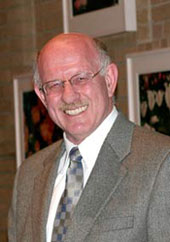
Handy Links
SLAC News Center
SLAC Today
- Subscribe
- Archives: Feb 2006-May 20, 2011
- Archives: May 23, 2011 and later
- Submit Feedback or Story Ideas
- About SLAC Today
SLAC News
Lab News
- Interactions
- Lightsources.org
- ILC NewsLine
- Int'l Science Grid This Week
- Fermilab Today
- Berkeley Lab News
- @brookhaven TODAY
- DOE Pulse
- CERN Courier
- DESY inForm
- US / LHC
SLAC Links
- Emergency
- Safety
- Policy Repository
- Site Entry Form

- Site Maps
- M & O Review
- Computing Status & Calendar
- SLAC Colloquium
- SLACspeak
- SLACspace
- SLAC Logo
- Café Menu
- Flea Market
- Web E-mail
- Marguerite Shuttle
- Discount Commuter Passes
-
Award Reporting Form
- SPIRES
- SciDoc
- Activity Groups
- Library
Stanford
Around the Bay
From the Director Emeritus: Promoting International Science and Education

The call came out of the blue in October 2009—a professional recruiter asking if I would be interested in joining OIST, the Okinawa Institute of Science and Technology. I had to admit to the caller that I, like most of you, had not heard of OIST. He provided me with a short and tantalizing explanation about OIST and more pointedly about its future. Would I allow my name to go forward as a candidate for the presidency of the yet-to-be-opened graduate university on the Japanese island of Okinawa, he asked. Curious by now, I thanked the gentleman and told him that I would first have to educate myself about OIST. So I looked up the Web site and soon found my way to a list of the Board of Governors. A more impressive group of people you could not find—familiar names like Steven Chu, Jerome (Jerry) Friedman, Akito Arima, Y.T. Lee, Martin Rees and Tim Hunt, to name but a few. I found Web pages depicting massive construction of a university campus, situated a mile above the beautiful coastline of the East China Sea in western Okinawa. And so began an eight-month journey that ended this past week with me enthusiastically accepting the OIST Graduate University Presidency.
What is so magnetic about this opportunity? In short, the privilege of helping to create a new international graduate university positioned by its founding precepts to conduct world-class, interdisciplinary science, limited only by the imagination and ingenuity of the research staff. It is a bold enterprise aimed at blending the rich Ryukyuan culture of Okinawa with the myriad cultures inherent in an international group of scientists. A grand, high-risk endeavor? Perhaps—but one for which the scientific, educational and cultural payoff is, to my mind, going to be transformative.
The university will have about 50 faculty members and 120 graduate students. With postdocs and staff scientists, the research core will number about 400. In addition there will be another 100 administrative and support staff members. At least half of the faculty, students and research staff members are separately mandated to be non-Japanese. The teaching and administrative language of the university will be English. All students will be on full scholarship, and so will not have to pay for their tuition or housing. Faculty will compete for a portion of the subsidized research funds that come annually to the university with its operating budget. Thus faculty members will not be required to generate all of their research funding from external sources. In addition, central funding is provided for purchasing and operating shared equipment and resources. Taken all together, faculty members at OIST will be well funded, will be free to choose their research emphasis, and will have more than 80 percent of their time available to do research.
The university will become official in the fall of 2011, when it is expected to receive its accreditation. The first class of students will be admitted in September 2012. By then, it is anticipated that about 50 faculty will be in place.
In anticipation of the opening of the university, much has been accomplished. The campus was designed by an international team of architects and construction is ongoing. Since 2005, an interim organization has built up a research enterprise comprising 24 groups, each led by a principal investigator. These groups are actively doing frontline research. The main building of the university and one of three large research laboratory buildings were finished this past April, allowing many of the current research groups access to the new facilities.
While much has been accomplished, there is much yet to put into place before the first class commences. Most important of all is to bring in outstanding faculty and students: without them it will not be possible to achieve the best-in-world standard that is expected.
I have been privileged to work at SLAC and Stanford for the past 34 years. Leaving my SLAC family is not easy in any way, but I carry, indelibly etched into my being, the extraordinary opportunities that SLAC and Stanford gave me and the honor and joy of working with so many exceptional people at SLAC and on the main campus. I am able to carry forward those remarkable experiences to the opportunity at OIST—a new platform from which to help guide brilliant minds to produce transformational discoveries.
